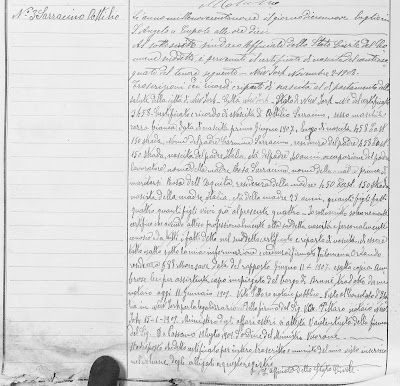Your family tree research has a long way to go if your oldest generation has last names.
But you're in a whole 'nother class of family tree research when you've gotten back to ancestors with no last names. And most of us won't get there.
 |
| It's the "The Conqueror" family! (12th century - Lucien Musset's The Bayeux Tapestry ISBN 9781843831631, Public Domain, Link |
Last names, or surnames, or cognomi in Italian, didn't exist several centuries ago. Most people couldn't read or write, and they didn't travel far. So formal last names weren't needed.
Chinese last names are one very big exception. Around 2852 B.C. it's believed the Chinese emperor ordered his people to adopt last names. Those last names had to come from a sacred poem of the time. This would explain why most Chinese people to this day have as few as 60 last names among them. [source: www.lifescript.com]
In the medieval days of Europe (picture "Monty Python and the Holy Grail"), last names weren't needed. Once civilizations began collecting taxes from their people, they started recording their names. They needed a way to tell people apart so they knew who to hound for those taxes.
Enter the surname.
There are four basic surname types.
1. Occupational Surnames
Some Western European cultures began using their trade as a last name (Smith, Shoemaker/Schumacher, Wright, Miller).
2. Patronymic (or Matronymic) Surnames
Some cultures used surnames based on male names (Johnson, Ericson, MacDonald) or female names. The form of a surname meaning "son of the father" takes on a different variation in different cultures:
- Fitzgerald means son of Gerald
- Ivanovich means son of Ivan
- DiGiovanni means son of Giovanni
- Stefanowicz means son of Stefan
3. Topographical Surnames
Some cultures used place names (Palermo, Napoli). Place names might also be a description of a place (Hill, Ford, Glen[n]). The last name Church is common in multiple languages (including Léglise, Iglesias). Place names are also why many Polish names end in -ski. Someone from Gryzbow might be named Gryzbowski.
4. Descriptive Surnames
In some cases the noble class of a society imposed an unflattering surname on someone of a lower class. As time went on, the bad meaning of the surname became accepted as a name and not an insult. Descriptive names can be friendly (Young, Good, Brown/Braun/Bruno) or based on an undesirable characteristic (Basso means short, Grosso means fat). A redhead might be called Russo or Rubino.
As early as the 11th century, people decided to pass this assumed surname to their children, making it a family name. [source: http://forebears.io/surnames]
These basic formations of names explain many of the last names in our family trees.
To learn about name variations, plus surname prefixes (Mc, Mac, Del) and suffixes (etti, ella) in various nationalities, see:
- Australian names
- English names
- French names
- German names
- Italian names
- Polish names
- Scottish names
- Spanish names
It's easy if you're Valerie Bertinelli and a big TV show traces your tree back to William the Conqueror. But for the rest of us, the paper trail may never get us back that far. So don't believe the genealogy fan who tells you their tree goes back to Adam or Noah.




